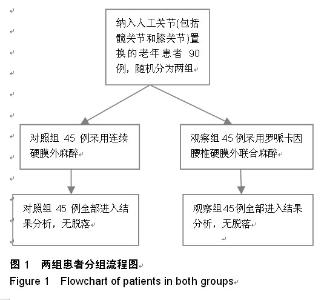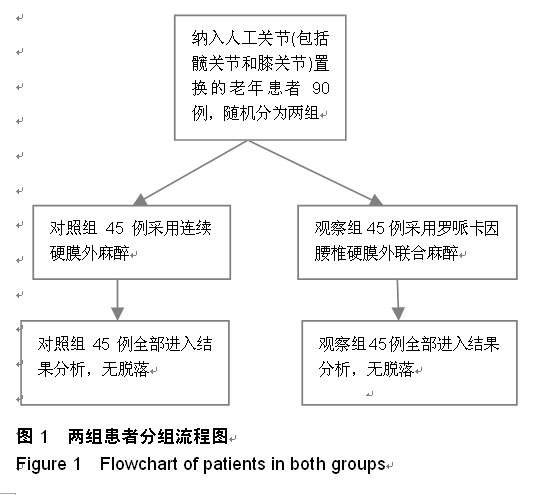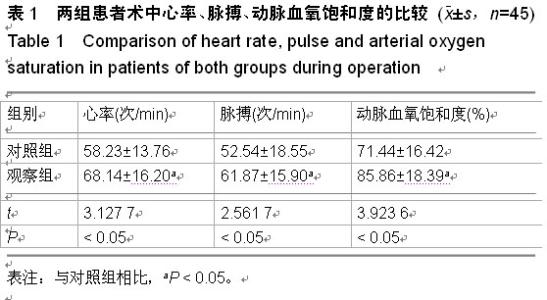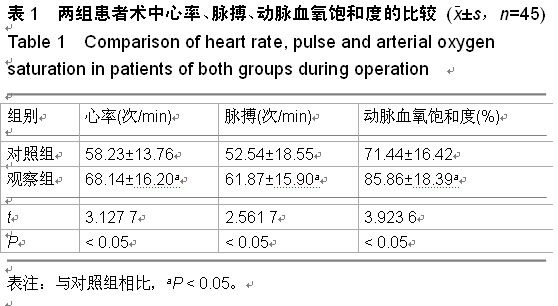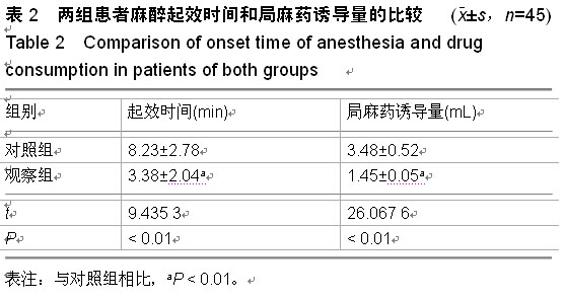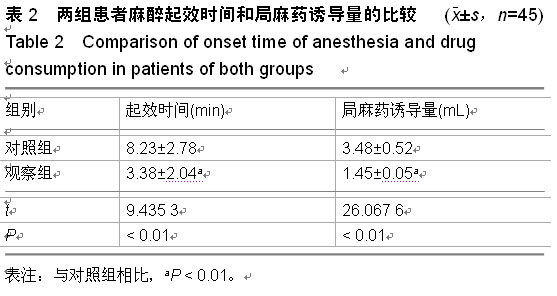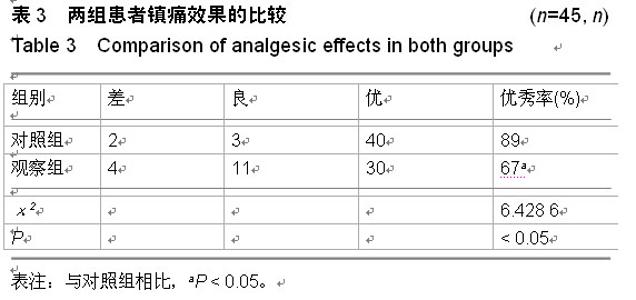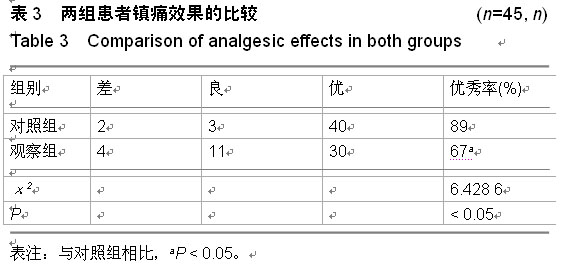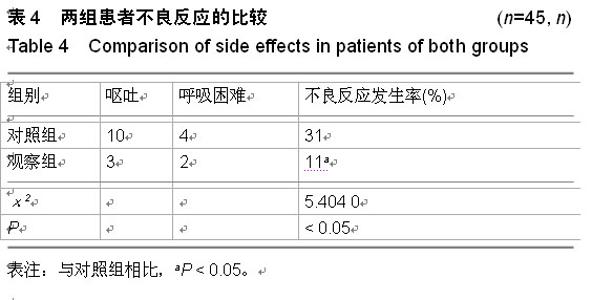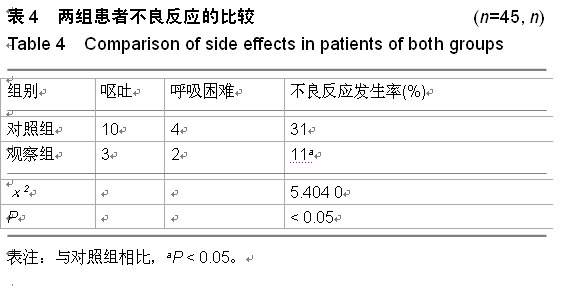Chinese Journal of Tissue Engineering Research ›› 2015, Vol. 19 ›› Issue (22): 3477-3481.doi: 10.3969/j.issn.2095-4344.2015.22.007
Previous Articles Next Articles
Combined spinal-epidural anesthesia with ropicavaine in elderly patients undergoing knee or hip arthroplasty: low incidence of postoperative side effects
Niu Xuan-yao
- Department of Anesthesiology, Heze Municipal Hospital, Heze 274000, Shandong Province, China
-
Received:2015-03-16Online:2015-05-28Published:2015-05-28 -
About author:Niu Xuan-yao, Attending physician, Department of Anesthesiology, Heze Municipal Hospital, Heze 274000, Shandong Province, China
CLC Number:
Cite this article
share this article
| [1] 王玉群.罗哌卡因腰硬联合麻醉在老年人髋关节手术的应用[J]. 中国实用医药,2013,8(29):132-133.
[2] 梁志强. 罗哌卡因腰-硬联合麻醉在老年患者手术中的应用[J]. 医学综述,2013,19(17):3263-3265.
[3] Brimblecombe CN, Lim WK, Sunderland Y. Preoperative comprehensive geriatric assessment: outcomes in elective lower limb joint replacement surgery for complex older adults. J Am Geriatr Soc. 2014;62(7):1396-1398.
[4] 周育南.罗哌卡因腰椎硬膜外联合在老年下肢骨关节置换术中的麻醉效果分析[J].临床合理用药,2013,6(11):114-115.
[5] Xiang Y, Chen CQ, Chen HJ, et al. The effect of epidural lidocaine administration on sedation of propofol general anesthesia: a randomized trial. J Clin Anesth. 2014;26(7): 523-529.
[6] Yavuz N, Taspinar V, Karasu D, et al. The effects of intraarticular levobupivacaine and bupivacaine injection on the postoperative pain management in total knee artroplastic surgery. Pak J Med Sci. 2014;30(6): 1286-1292.
[7] Bedir EB, Kurtulmus T, Basyigit S, et al. A comparison of epidural analgesia and local infiltration analgesia methods in pain control following total knee arthroplasty. Acta Orthop Traumatol Turc. 2014;48(1):73-79.
[8] 王诚,李琦,王宇冬. 罗哌卡因腰椎硬膜外联合麻醉在老年下肢骨关节置换术中的应用[J].中国老年学杂志,2012,32(19): 4318-4319.
[9] Kim WH, Lee JH, Ko JS, et al. The effect of body mass index on spinal anaesthesia for total knee replacement arthroplsty: a dose-response study. Anaesth Intens Care. 2012;40(3): 410-416.
[10] Sizlan A, Atim A, Yurttas Y, et al. A comparison of the efficacy of bupivacaine and levobupivacaine in patient-controlled epidural analgesia for postoperative pain in patients undergoing knee arthroplasty. Eklem Hast Cerrahisi. 2012; 23(3):134-139.
[11] 晋清泉,任娟,马友田.罗哌卡因复合舒芬太尼用于高龄患者髋关节置换术的最低有效剂量[J].中外医疗,2014,34(24):113-115.
[12] Clement ND, Breusch SJ, Biant LC, et al. Lower limb joint replacement in rheumatoid arthritis.J Orthop Surg Res.2012; 7:27.
[13] Jørgensen CC, Jans Ø, Kehlet H, et al. Preoperative anaemia and newly diagnosed cancer 1 year after elective total hip and kneearthroplasty. Vox Sang. 2015. doi: 10.1111/vox.12255. [Epub ahead of print]
[14] Banerjee S, Little T, Little N. Intramedullary fixation of pertrochanteric fractures after hip resurfacing arthroplasty - Do we have the answer? Case report and literature review. J Orthop. 2014;12(2):66-69.
[15] Tudor FS, Donaldson JR, Rodriguez-Elizalde SR, et al. Long-Term Comparison of Porous Versus Hydroxyapatite Coated Sleeve of a Modular Cementless Femoral Stem (SROM) in Primary Total Hip Arthroplasty. J Arthroplasty. 2015. pii: S0883-5403(15)00321-6.
[16] Leucht P, Huddleston HG, Bellino MJ, Does Intraoperative Fluoroscopy Optimize Limb Length and the Precision of Acetabular Positioning in Primary THA? Orthopedics. 2015; 38(5):e380-386.
[17] Zhang Y, Cheng T, Zhang XL. Changes in Intra-pelvic Obliquity Angle 0-2 Years After Total Hip Arthroplasty and Its Effects on Leg Length Discrepancy: A Retrospective Study. Chin Med J (Engl). 2015 20th May;128(10):1346-1350.
[18] Zhao X, Hu D, Qin J, et al. Effect of bisphosphonates in preventing femoral periprosthetic bone resorption after primary cementless total hip arthroplasty: a meta-analysis. J Orthop Surg Res. 2015;10(1):65.
[19] Jensen C, Rosenlund S, Nielsen DB, et al. The use of the Gait Deviation Index for the evaluation of participants following total hip arthroplasty: An explorative randomized trial. Gait Posture. 2015. pii: S0966-6362(15)00043-0.
[20] Putzer D, Klug S, Haselbacher M, et al. Retracting Soft Tissue in Minimally Invasive Hip Arthroplasty Using a Robotic Arm: A Comparison Between a Semiactive Retractor Holder and Human Assistants in a Cadaver Study. Surg Innov. 2015. pii: 1553350615586110.
[21] Cip J, Bach C, Widemschek M, et al. Revision of Articular Surface Replacement (ASR) Total Hip Arthroplasty: Correlation of Perioperative Data and Early Post-Revision Outcome Results. J Arthroplasty. 2015. pii: S0883-5403(15) 00275-2.
[22] Rade MC, Yadeau JT, Ford C, et al. Postoperative delirium in elderly patients after elective hip or knee arthroplasty performed under regional anesthesia. HSS J. 2011;7(2): 151-156.
[23] Kim JH, Cho MR, Kim SO,et al. A comparison of femoral/sciatic nerve block with lateral femoral cutaneous nerve block and combined spinal epidural anesthesia for total knee replacement arthroplasty. Korean J Anesthesiol. 2012; 62(5):448-453.
[24] Kim WH, Lee JH, Ko JS, et al. The effect of body mass index on spinal anaesthesia for total knee replacement arthroplasty: a dose-response study. Anaesth Intensive Care. 2012;40(3): 410-416.
[25] Ng V, Lai A, Ho V. Comparison of forced-air warming and electric heating pad for maintenance of body temperature during total knee replacement. Anaesthesia. 2006;61(11): 1100-1104.
[26] Westrich GH, Bottner F, Windsor RE, et al. VenaFlow plus Lovenox vs VenaFlow plus aspirin for thromboembolic disease prophylaxis in totalknee arthroplasty. J Arthroplasty. 2006;21(6 Suppl 2):139-143.
[27] Ezri T, Zahalka I, Zabeeda D, et al. Similar incidence of hypotension with combined spinal-epidural or epidural alone for knee arthroplasty. Can J Anaesth. 2006;53(2):139-145.
[28] Han G, Zhao GY, Li L, et al. Comparison of hemodynamics after combined spinal-epidural anesthesia between decubitus and sitting positions in aged patients undergoing total hip replacement. Pharmacology. 2014;93(3-4):193-196.
[29] Rade MC, Yadeau JT, Ford C, et al. Postoperative delirium in elderly patients after elective hip or knee arthroplasty performed under regional anesthesia. HSS J. 2011;7(2): 151-156.
[30] Dobrydnjov I, Axelsson K, Gupta A, et al. Improved analgesia with clonidine when added to local anesthetic during combined spinal-epiduralanesthesia for hip arthroplasty: a double-blind, randomized and placebo-controlled study. Acta Anaesthesiol Scand. 2005;49(4):538-545.
[31] Paul JE, Nantha-Aree M, Buckley N, et al. Randomized controlled trial of gabapentin as an adjunct to perioperative analgesia in total hiparthroplasty patients. Can J Anaesth. 2015;62(5):476-484.
[32] Zhu L, Tian C, Li M, et al. The stress response and anesthetic potency of unilateral spinal anesthesia for total Hip Replacement in geriatric patients. Pak J Pharm Sci. 2014; 27(6 Suppl):2029-2034.
[33] Bayazit EG, Karaaslan K, Ozturan K, et al. Effect of epidural levobupivacaine and levobupivacaine with fentanyl on stress response and postoperative analgesia after total knee replacement. 2013;51(8): 652-659.
[34] 李蕊.罗哌卡因腰-硬联合麻醉在高龄患者髋部及下肢骨科手术中的应用[J].中华实用诊断与治疗杂志,2013,27(1):72-73.
[35] Lv BS, Wang W, Wang ZQ, et al. Efficacy and safety of local anesthetics bupivacaine, ropivacaine and levobupivacaine in combination with sufentanil in epidural anesthesia for labor and delivery: a meta-analysis. Curr Med Res Opin. 2014; 30(11):2279-2289.
[36] Cao S, Wang Y, Zhang X, et al. Levels of antioxidants in the spinal fluid after induction of anesthesia with ropivacaine. Drug Res. 2014;64(11):603-606.
[37] 郭洪庆.罗哌卡因腰-硬联合麻醉用于老年全髋置换术的效果[J]. 中国医学指南,2013,11(14):278-279.
[38] Canturk M, Kilci O, Ornek D, et al. Ropivacaine for unilateral spinal anesthesia; hyperbaric or hypobaric? Rev Bras Anestesiol. 2012;62(3): 298-311.
中国组织工程研究杂志出版内容重点:人工关节;骨植入物;脊柱;骨折;内固定;数字化骨科;组织工程
|
| [1] | Chen Ziyang, Pu Rui, Deng Shuang, Yuan Lingyan. Regulatory effect of exosomes on exercise-mediated insulin resistance diseases [J]. Chinese Journal of Tissue Engineering Research, 2021, 25(25): 4089-4094. |
| [2] | Chen Yang, Huang Denggao, Gao Yuanhui, Wang Shunlan, Cao Hui, Zheng Linlin, He Haowei, Luo Siqin, Xiao Jingchuan, Zhang Yingai, Zhang Shufang. Low-intensity pulsed ultrasound promotes the proliferation and adhesion of human adipose-derived mesenchymal stem cells [J]. Chinese Journal of Tissue Engineering Research, 2021, 25(25): 3949-3955. |
| [3] | Yang Junhui, Luo Jinli, Yuan Xiaoping. Effects of human growth hormone on proliferation and osteogenic differentiation of human periodontal ligament stem cells [J]. Chinese Journal of Tissue Engineering Research, 2021, 25(25): 3956-3961. |
| [4] | Sun Jianwei, Yang Xinming, Zhang Ying. Effect of montelukast combined with bone marrow mesenchymal stem cell transplantation on spinal cord injury in rat models [J]. Chinese Journal of Tissue Engineering Research, 2021, 25(25): 3962-3969. |
| [5] | Gao Shan, Huang Dongjing, Hong Haiman, Jia Jingqiao, Meng Fei. Comparison on the curative effect of human placenta-derived mesenchymal stem cells and induced islet-like cells in gestational diabetes mellitus rats [J]. Chinese Journal of Tissue Engineering Research, 2021, 25(25): 3981-3987. |
| [6] | Hao Xiaona, Zhang Yingjie, Li Yuyun, Xu Tao. Bone marrow mesenchymal stem cells overexpressing prolyl oligopeptidase on the repair of liver fibrosis in rat models [J]. Chinese Journal of Tissue Engineering Research, 2021, 25(25): 3988-3993. |
| [7] | Liu Jianyou, Jia Zhongwei, Niu Jiawei, Cao Xinjie, Zhang Dong, Wei Jie. A new method for measuring the anteversion angle of the femoral neck by constructing the three-dimensional digital model of the femur [J]. Chinese Journal of Tissue Engineering Research, 2021, 25(24): 3779-3783. |
| [8] | Meng Lingjie, Qian Hui, Sheng Xiaolei, Lu Jianfeng, Huang Jianping, Qi Liangang, Liu Zongbao. Application of three-dimensional printing technology combined with bone cement in minimally invasive treatment of the collapsed Sanders III type of calcaneal fractures [J]. Chinese Journal of Tissue Engineering Research, 2021, 25(24): 3784-3789. |
| [9] | Qian Xuankun, Huang Hefei, Wu Chengcong, Liu Keting, Ou Hua, Zhang Jinpeng, Ren Jing, Wan Jianshan. Computer-assisted navigation combined with minimally invasive transforaminal lumbar interbody fusion for lumbar spondylolisthesis [J]. Chinese Journal of Tissue Engineering Research, 2021, 25(24): 3790-3795. |
| [10] | Hu Jing, Xiang Yang, Ye Chuan, Han Ziji. Three-dimensional printing assisted screw placement and freehand pedicle screw fixation in the treatment of thoracolumbar fractures: 1-year follow-up [J]. Chinese Journal of Tissue Engineering Research, 2021, 25(24): 3804-3809. |
| [11] | Shu Qihang, Liao Yijia, Xue Jingbo, Yan Yiguo, Wang Cheng. Three-dimensional finite element analysis of a new three-dimensional printed porous fusion cage for cervical vertebra [J]. Chinese Journal of Tissue Engineering Research, 2021, 25(24): 3810-3815. |
| [12] | Wang Yihan, Li Yang, Zhang Ling, Zhang Rui, Xu Ruida, Han Xiaofeng, Cheng Guangqi, Wang Weil. Application of three-dimensional visualization technology for digital orthopedics in the reduction and fixation of intertrochanteric fracture [J]. Chinese Journal of Tissue Engineering Research, 2021, 25(24): 3816-3820. |
| [13] | Sun Maji, Wang Qiuan, Zhang Xingchen, Guo Chong, Yuan Feng, Guo Kaijin. Development and biomechanical analysis of a new anterior cervical pedicle screw fixation system [J]. Chinese Journal of Tissue Engineering Research, 2021, 25(24): 3821-3825. |
| [14] | Lin Wang, Wang Yingying, Guo Weizhong, Yuan Cuihua, Xu Shenggui, Zhang Shenshen, Lin Chengshou. Adopting expanded lateral approach to enhance the mechanical stability and knee function for treating posterolateral column fracture of tibial plateau [J]. Chinese Journal of Tissue Engineering Research, 2021, 25(24): 3826-3827. |
| [15] | Zhu Yun, Chen Yu, Qiu Hao, Liu Dun, Jin Guorong, Chen Shimou, Weng Zheng. Finite element analysis for treatment of osteoporotic femoral fracture with far cortical locking screw [J]. Chinese Journal of Tissue Engineering Research, 2021, 25(24): 3832-3837. |
| Viewed | ||||||
|
Full text |
|
|||||
|
Abstract |
|
|||||
